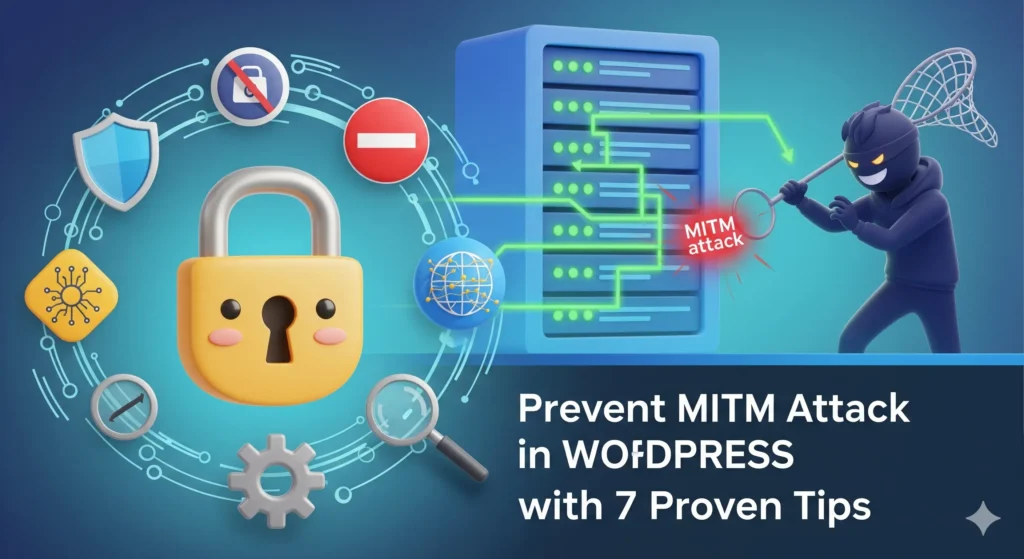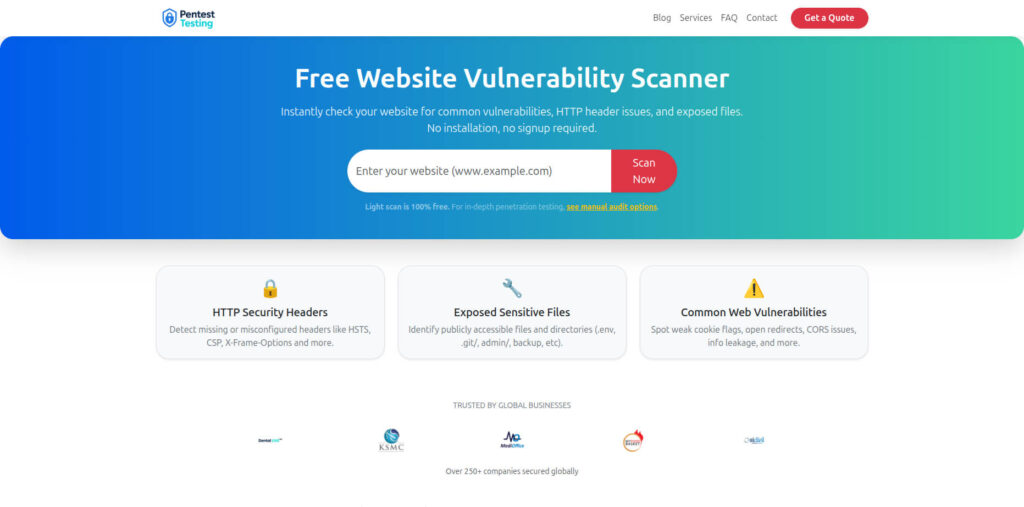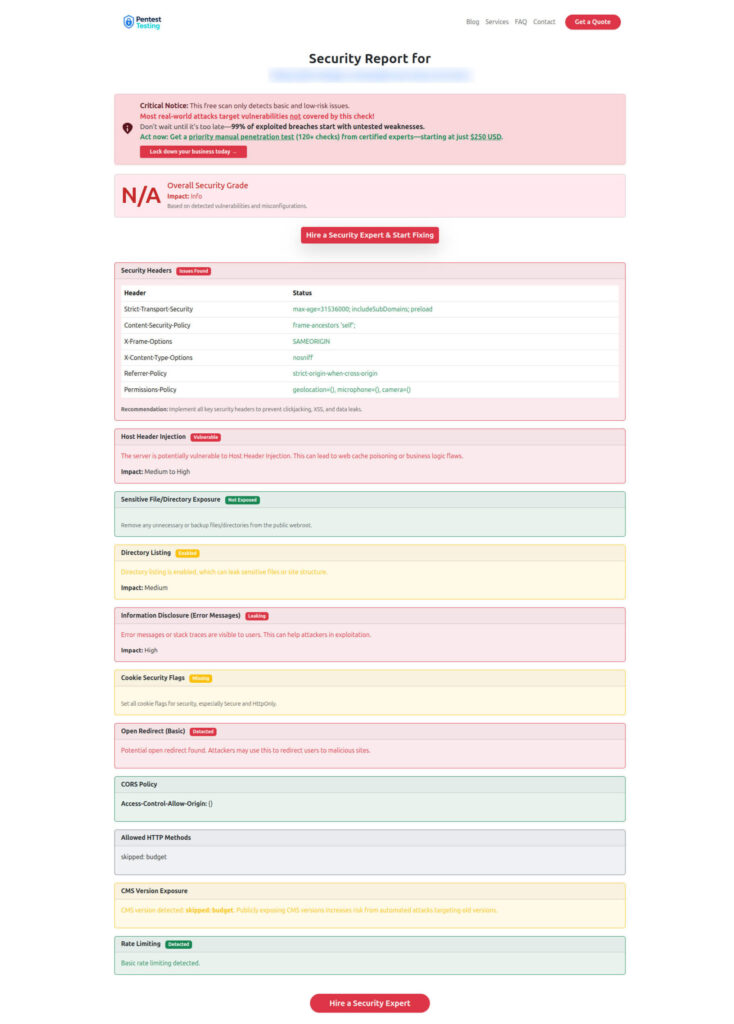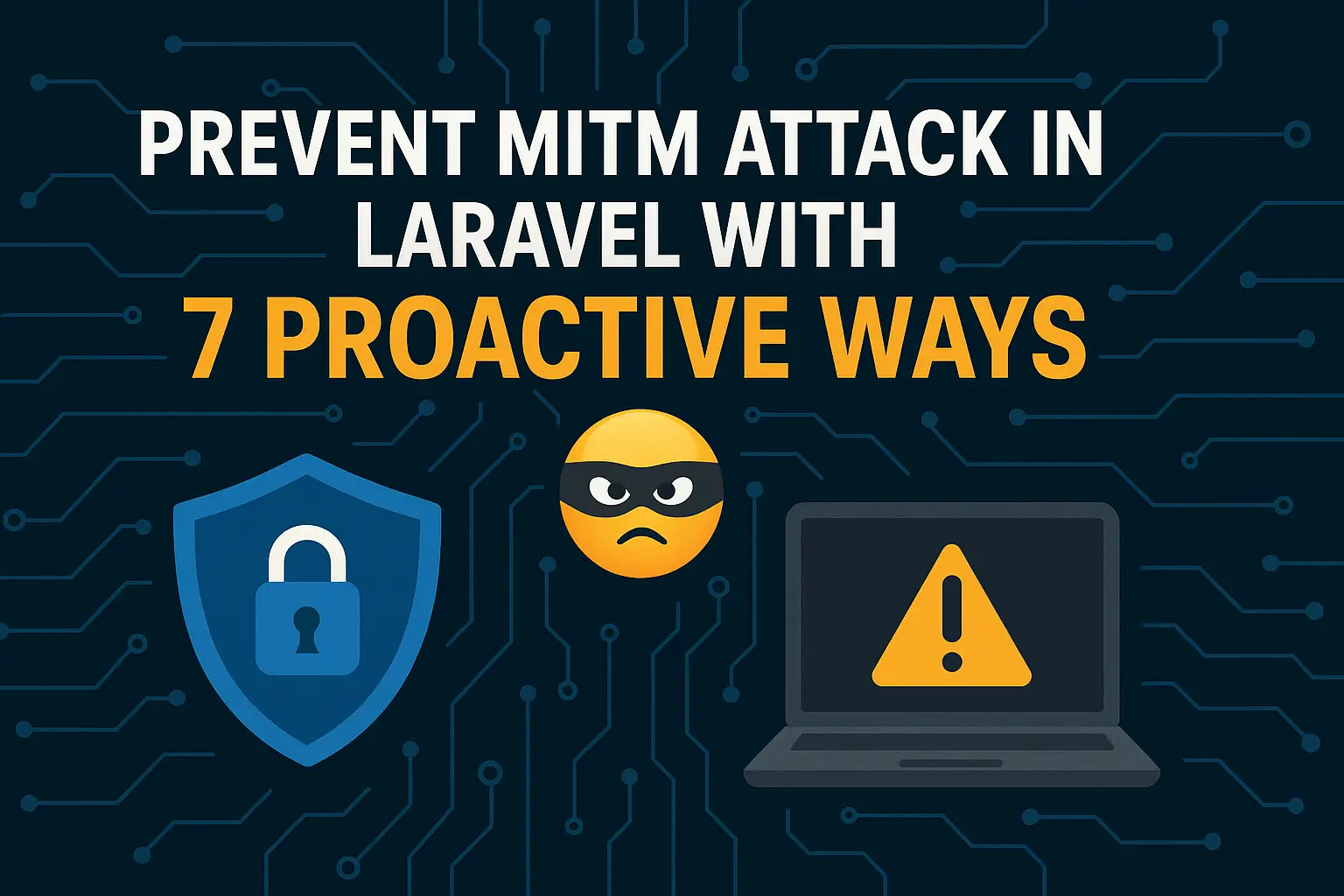Prevent MITM Attack in WordPress & Fix Session Fixation (Complete Guide)
If you run a WordPress site, two threats can quietly hand attackers the keys to your users’ accounts: session fixation and man-in-the-middle (MITM) interception. This guide shows you how to Prevent MITM Attack in WordPress while eliminating session fixation at the code, server, and configuration layers—so your WordPress security is resilient, fast, and future-proof.

✅ Quick win: run a free external audit first. It takes ~2 minutes and highlights weak cookies, mixed content, and header gaps.
Scan your site with Pentest Testing Corp’s Free Website Vulnerability Scanner.
What is Session Fixation—and why it enables MITM
Session fixation occurs when an attacker sets or predicts a victim’s session identifier (session ID or auth cookie) before the victim logs in. After the victim authenticates, the attacker reuses that known identifier to impersonate them.
In WordPress, core authentication relies on secure cookies (not PHP $_SESSION by default). However, many themes/plugins introduce PHP sessions, custom cookies, or fragile redirects that can reopen fixation vectors. When this meets a MITM (e.g., unsecured Wi-Fi, SSL stripping, or proxying), an attacker can observe or inject traffic to nudge users into a fixed session or steal weak cookies.
Your defense strategy is to Prevent MITM Attack in WordPress at the transport layer (TLS, HSTS, redirects, headers) and eliminate session-fixation in code (cookie flags, nonce validation, session rotation).
Executive Checklist (5-minute overview)
- Always-on HTTPS + HSTS (+ preload) to Prevent MITM Attack in WordPress.
- Force secure, HttpOnly, SameSite cookies; rotate tokens on login.
- Kill unsafe PHP session usage; if used, call
session_regenerate_id(true)on auth. - Block mixed content; set CSP
upgrade-insecure-requests. - Use nonces in all state-changing actions (forms, AJAX).
- Enable 2FA and limit session lifespan.
- Continuously scan with free.pentesttesting.com and fix findings.
Screenshot of the Website Vulnerability Scanner Webpage

Step 1 — Force HTTPS in WordPress (Core Hardening)
To Prevent MITM Attack in WordPress, start by forcing TLS for admin and logins:
wp-config.php
// Force SSL on admin and logins
if (!defined('FORCE_SSL_ADMIN')) {
define('FORCE_SSL_ADMIN', true);
}Set your Site Address (URL) and WordPress Address (URL) to https:// in Settings → General (or via WP-CLI):
# WP-CLI: force https URLs
wp option update home 'https://example.com'
wp option update siteurl 'https://example.com'Apache .htaccess (redirect HTTP → HTTPS):
RewriteEngine On
RewriteCond %{HTTPS} !=on
RewriteRule ^ https://%{HTTP_HOST}%{REQUEST_URI} [R=301,L]Nginx (redirect server block):
server {
listen 80;
server_name example.com www.example.com;
return 301 https://$host$request_uri;
}Step 2 — HSTS to Stop SSL-Stripping
HSTS prevents downgrades and helps Prevent MITM Attack in WordPress by disallowing HTTP:
Apache
# send HSTS for 2 years, include subdomains, request preload
Header always set Strict-Transport-Security "max-age=63072000; includeSubDomains; preload"Nginx
add_header Strict-Transport-Security "max-age=63072000; includeSubDomains; preload" always;Submit your domain to the HSTS preload list after confirming all subdomains are HTTPS-only.
Step 3 — Cookie Security: Secure, HttpOnly, SameSite
Well-configured cookies defeat fixation + MITM sniffing. WordPress core sets robust auth cookies, but make the security explicit:
Theme/Plugin (functions.php or mu-plugin)
// Always use secure cookies on HTTPS sites
add_filter('secure_auth_cookie', '__return_true');
add_filter('secure_logged_in_cookie', '__return_true');
// Force cookies to be HttpOnly/SameSite=Lax|Strict where you set custom cookies
function ptc_set_strict_cookie($name, $value, $ttl = 3600) {
setcookie($name, $value, [
'expires' => time() + $ttl,
'path' => COOKIEPATH ? COOKIEPATH : '/',
'domain' => COOKIE_DOMAIN,
'secure' => true,
'httponly' => true,
'samesite' => 'Lax', // or 'Strict' if it fits your UX
]);
}If a plugin uses PHP sessions, also harden PHP:
.user.ini (or php.ini)
session.use_only_cookies = 1
session.cookie_secure = 1
session.cookie_httponly = 1
session.cookie_samesite = Lax
session.use_strict_mode = 1
session.use_trans_sid = 0These settings help Prevent MITM Attack in WordPress by stopping SID leakage and cookie theft on hostile networks.
Step 4 — Rotate Tokens on Login (End Fixation)
If any plugin introduces sessions or sets pre-auth cookies, regenerate IDs at the point of authentication:
// Rotate any PHP session ID and kill other sessions on successful login
add_action('wp_login', function($user_login, $user) {
if (session_id()) {
session_regenerate_id(true); // critical for session fixation defense
}
if (function_exists('wp_destroy_other_sessions')) {
wp_destroy_other_sessions(); // kill parallel sessions for this user
}
}, 10, 2);Also shorten cookie life for sensitive roles:
// Reduce auth cookie expiry for admins (e.g., 8 hours)
add_filter('auth_cookie_expiration', function($seconds, $user_id, $remember){
if (user_can($user_id, 'manage_options')) {
return 8 * HOUR_IN_SECONDS;
}
return $seconds;
}, 10, 3);Step 5 — Nonces Everywhere (Stop CSRF → Stops Fixation Abuse)
Attackers often pair fixation with CSRF. Use WordPress nonces for every state-changing request.
Form (template.php)
<form method="post">
<?php wp_nonce_field('ptc_update_profile', 'ptc_nonce'); ?>
<!-- fields -->
<button type="submit">Update</button>
</form>Handler (functions.php)
add_action('admin_post_ptc_save', function() {
if (!isset($_POST['ptc_nonce']) || !wp_verify_nonce($_POST['ptc_nonce'], 'ptc_update_profile')) {
wp_die('Security check failed', 403);
}
// sanitize and process...
});AJAX example
// JS
jQuery.post(ajaxurl, {
action: 'ptc_secure_action',
_wpnonce: ptcVars.nonce,
payload: 'data'
});
// PHP
add_action('wp_ajax_ptc_secure_action', function(){
check_ajax_referer('ptc_nonce_key');
// process...
wp_send_json_success(['ok' => true]);
});
// Localize nonce
add_action('wp_enqueue_scripts', function(){
wp_enqueue_script('ptc', get_stylesheet_directory_uri().'/ptc.js', ['jquery'], null, true);
wp_localize_script('ptc', 'ptcVars', ['nonce' => wp_create_nonce('ptc_nonce_key')]);
});Nonces don’t directly Prevent MITM Attack in WordPress, but they block the lateral moves attackers try once a fixed session exists.
Step 6 — Kill Mixed Content & Add Security Headers
Mixed content is a classic MITM foothold (resources loaded over HTTP). Add a Content-Security-Policy (CSP) to upgrade legacy HTTP links:
Apache
Header always set Content-Security-Policy "upgrade-insecure-requests"
Header always set X-Content-Type-Options "nosniff"
Header always set X-Frame-Options "SAMEORIGIN"
Header always set Referrer-Policy "strict-origin-when-cross-origin"Nginx
add_header Content-Security-Policy "upgrade-insecure-requests" always;
add_header X-Content-Type-Options "nosniff" always;
add_header X-Frame-Options "SAMEORIGIN" always;
add_header Referrer-Policy "strict-origin-when-cross-origin" always;These headers significantly Prevent MITM Attack in WordPress by removing downgrade paths.
Step 7 — Developer Pattern: Avoid URL-Based Sessions
Never accept session IDs via URL or query strings. If you write a plugin:
// BAD: reading SID from GET opens fixation via links
// $sid = $_GET['sid'] ?? null;
// GOOD: no SID in URLs; rely on secure HttpOnly cookies only
if (session_status() === PHP_SESSION_NONE) {
session_start();
}
// Rotate session on privilege change or login
if (is_user_logged_in()) {
session_regenerate_id(true);
}Step 8 — Example: Safe Login Redirects (No Open Redirects)
Open redirects can be chained with fixation to bounce victims into attacker-chosen flows.
add_filter('login_redirect', function($redirect_to, $request, $user){
$allowed = [
home_url('/'),
admin_url('/'),
home_url('/account/')
];
if (!in_array($redirect_to, $allowed, true)) {
return home_url('/account/');
}
return $redirect_to;
}, 10, 3);Step 9 — TLS Best Practices (Server-Side)
Use modern TLS ciphers and disable legacy protocols to Prevent MITM Attack in WordPress:
Nginx
ssl_protocols TLSv1.2 TLSv1.3;
ssl_prefer_server_ciphers on;
ssl_ciphers HIGH:!aNULL:!MD5:!3DES:!RC4;
ssl_session_cache shared:SSL:50m;
ssl_session_timeout 1d;
ssl_stapling on;
ssl_stapling_verify on;Step 10 — Continuous Verification (Free Scanner + Report)
Run the scan and compare against this checklist. You’ll spot insecure cookies, missing HSTS, mixed content, weak redirects, and more.
Sample Assessment Report from our tool to check Website Vulnerability

Real-World Playbook: Eliminate Session Fixation in a Plugin
A compact, production-ready pattern for plugin authors:
/**
* Plugin Name: PTC Session Hardener
*/
defined('ABSPATH') || exit;
// Start PHP session only if absolutely needed
add_action('init', function(){
if (session_status() === PHP_SESSION_NONE) {
session_start();
// Strict mode: drop uninitialized sessions
if (empty($_SESSION['ptc_init'])) {
$_SESSION['ptc_init'] = true;
session_regenerate_id(true);
}
}
}, 0);
// On login: rotate session + destroy other sessions
add_action('wp_login', function($user_login, $user){
if (session_id()) {
session_regenerate_id(true);
}
if (function_exists('wp_destroy_other_sessions')) {
wp_destroy_other_sessions();
}
}, 10, 2);
// Harden custom cookies if you must use them
function ptc_set_cookie($k, $v, $ttl = 1800) {
setcookie($k, $v, [
'expires' => time() + $ttl,
'path' => COOKIEPATH ?: '/',
'domain' => COOKIE_DOMAIN,
'secure' => is_ssl(),
'httponly' => true,
'samesite' => 'Lax',
]);
}This pattern directly disrupts fixation and helps Prevent MITM Attack in WordPress by shutting down cookie exposure avenues.
Bonus: Blocklist Public Wi-Fi Account Takeovers
- Enforce 2FA (TOTP/WebAuthn) for admins/editors.
- Shorten session life; require re-login on privilege changes.
- Audit logins via security plugins or custom logging.
- Educate users: “Never log into admin over public Wi-Fi without a VPN.”
- Schedule quarterly hardening reviews—pair the review with a fresh Website Security check.
Related how-to’s and deep dives
- Read: Security Misconfiguration in Node.js — good primer on config-level leaks that enable fixation/MITM.
- Read: Session Fixation in WordPress — shareable version of this topic.
- Read: Fix Sensitive Data Exposure in WordPress — stop tokens from leaking into logs/URLs.
- Read: Prevent Cross-Site Scripting (XSS) in Laravel — concepts map to WP too: output encoding & CSP.
- PCI DSS 4.0 remediation plan — What changed on Mar 31, 2025 + a 30/60/90-day sprint and auditor-ready evidence.
Each of these helps Prevent MITM Attack in WordPress by reducing the attacker’s ability to inject, steal, or replay credentials.
Services to accelerate your remediation
Managed IT Services — Stabilize your stack
Proactive patching, TLS lifecycle, and config governance—so you can Prevent MITM Attack in WordPress without whack-a-mole.
👉 Pentest Testing Managed IT Services
AI Application Cybersecurity — Modern app defense
Threat modeling for AI workflows, token hygiene, and secure session design for AI-driven features in WordPress.
👉 AI Application Cybersecurity
Partner Program — Offer security to your clients
Agencies/MSPs: resell audits and remediation with white-label reporting.
👉 Offer Cybersecurity Service to Your Client
Compliance & Risk Management — HIPAA, PCI DSS, SOC 2, ISO 27001, GDPR
Map fixes (HSTS, cookie policy, session controls) to controls evidence.
👉 Risk Assessment Services
👉 Remediation Services
Copy-Paste Remediation Pack (quick references)
Force SSL Admin
define('FORCE_SSL_ADMIN', true);Secure Cookies via Filters
add_filter('secure_auth_cookie', '__return_true');
add_filter('secure_logged_in_cookie', '__return_true');Rotate on Login
add_action('wp_login', function($u, $user){
if (session_id()) session_regenerate_id(true);
if (function_exists('wp_destroy_other_sessions')) wp_destroy_other_sessions();
}, 10, 2);HSTS
Header always set Strict-Transport-Security "max-age=63072000; includeSubDomains; preload"CSP & Essentials
Header always set Content-Security-Policy "upgrade-insecure-requests"
Header always set X-Content-Type-Options "nosniff"
Header always set X-Frame-Options "SAMEORIGIN"
Header always set Referrer-Policy "strict-origin-when-cross-origin"PHP Session Hygiene
session.use_only_cookies=1
session.use_strict_mode=1
session.use_trans_sid=0
session.cookie_secure=1
session.cookie_httponly=1
session.cookie_samesite=LaxCall to Action
You now have the exact steps to Prevent MITM Attack in WordPress and eliminate session fixation.
Start with a no-cost baseline:
- Run the Free Website Vulnerability Scanner to spot weak cookies, missing HSTS/CSP, and mixed content.
- Need hands-on help? Our Remediation Services implement these fixes quickly and safely.
🔐 Frequently Asked Questions (FAQs)
Find answers to commonly asked questions about MITM Attack in WordPress.


Pingback: Broken Access Control in Node.js: 7 Best Fixes